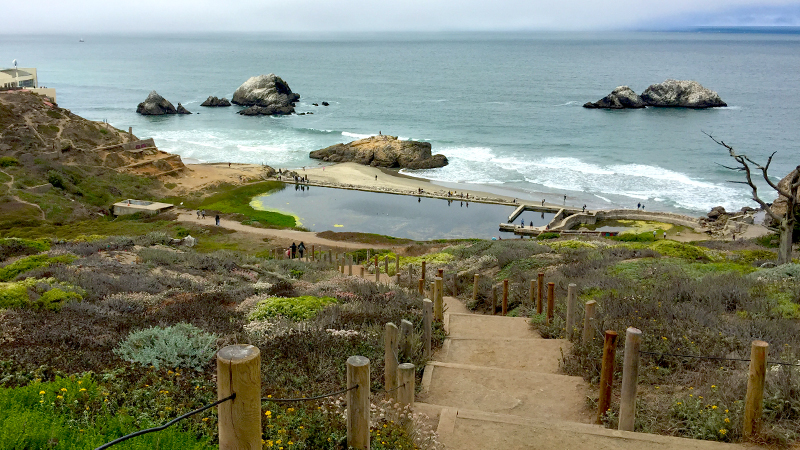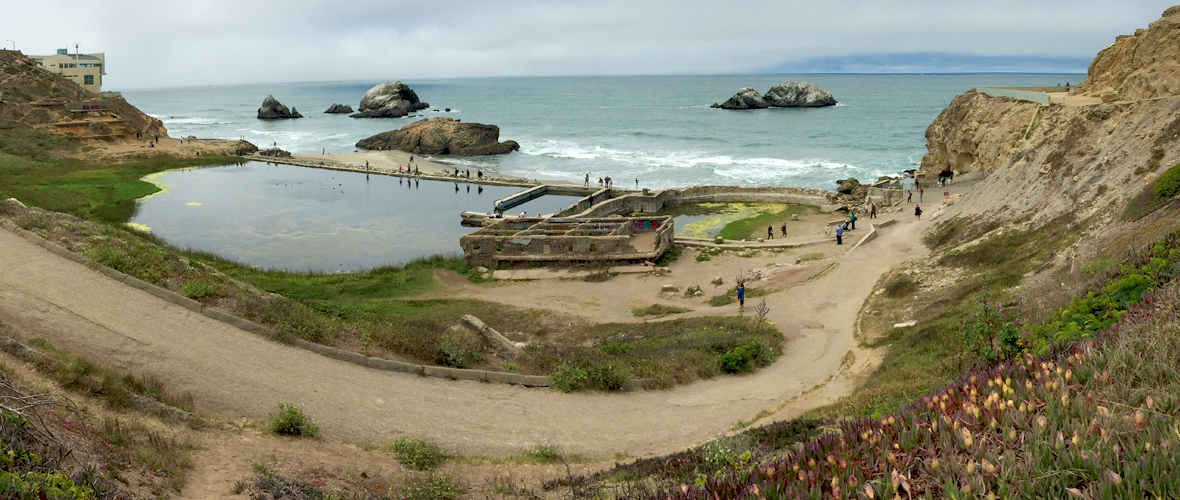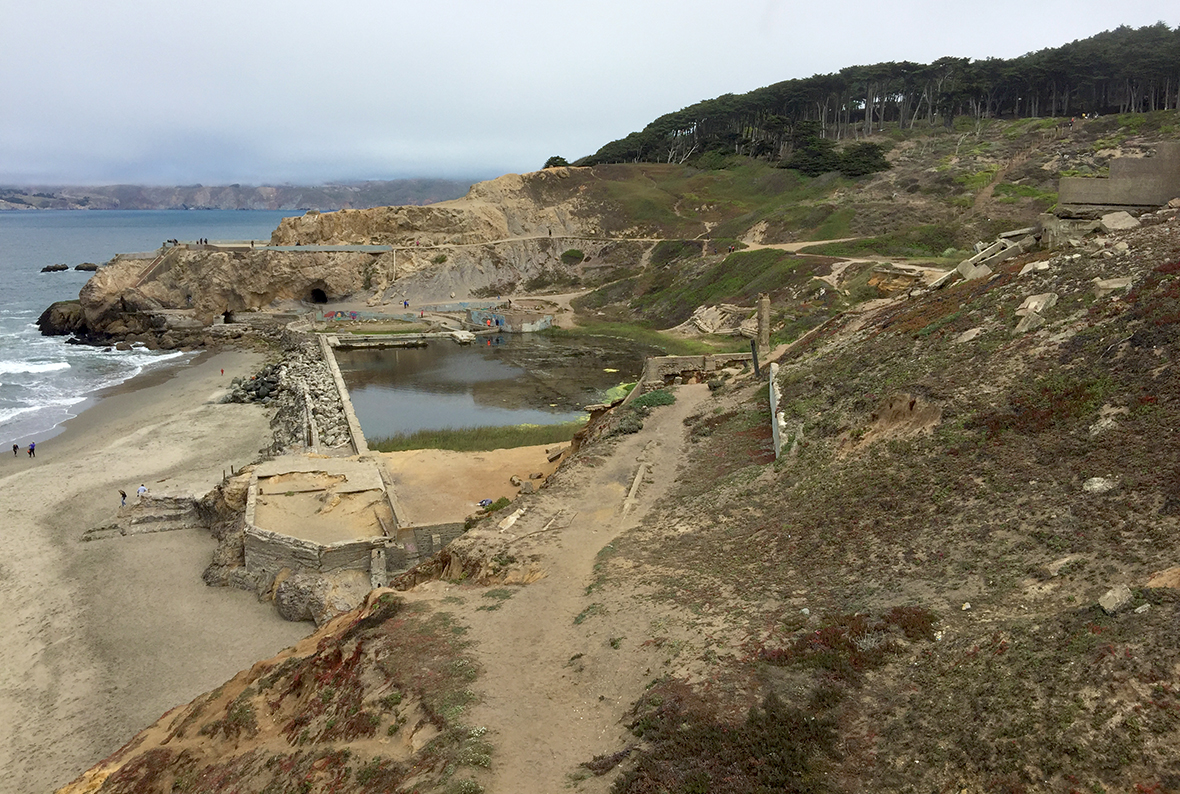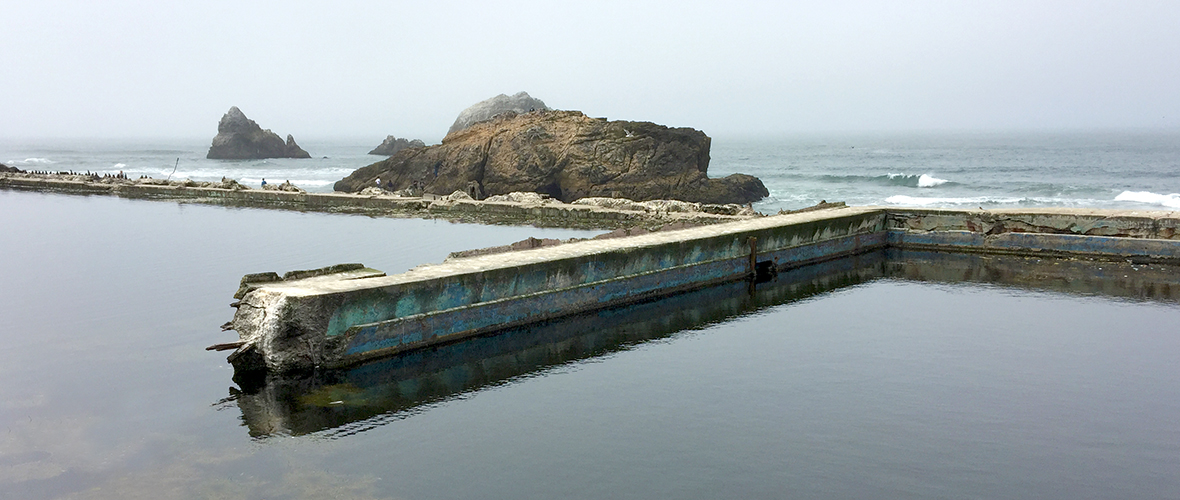
When we were planning a long weekend in San Francisco for Jerry Day, I knew I wanted to visit the Sutro Bath Ruins — the kids love any kind of old historic ruins. While researching the ruins, I found several other things do check out nearby in the Lands End area of San Francisco, so we decided to spend an entire day exploring Land’s End, starting with the ruins.
We woke up early Friday morning and hit the road, arriving at the Lands End Lookout just before 10:00 am. We wanted to get there early because parking can be a nightmare, and thankfully there were still several parking spaces in both the Lands End Lookout lot and the smaller lot across the street open.
We hopped out of the truck, grabbed sweatshirts, and walked out onto the decks behind the Cliff House to first checkout the ruins from high above. The minute Carter saw the old concrete foundations, a cave, and people walking around, he wanted to get down there fast. The kids were just as excited as Brian and I were to check out this historic and slightly eerie site.

Explore the Sutro Baths Ruins
Following the trail and staircases down to the Sutro Baths ruins took us past wildflowers and grasses and gave us a chance to see the ruins from yet another vantage point. Once at the old foundations, we were free to explore.
What blows my mind, is that the ruins aren’t maintained but open to the public. They’re pretty treacherous and there are no gates, ropes, or fences keeping you in any one area. There is no one watching over the area either. There is one sign that reads, “people have been swept from the rocks and drowned,” but overall, it’s pretty much a free for all and you’re on your own to make smart decisions and stay safe.
The sun was playing peek-a-boo behind the clouds for most of the day, and there was fog settling in and around the ruins when we first arrived, and it gave the entire area a creepy feeling — making our family adventure even more fun. Carter said that this this the kind of place that ghosts would live!
Before heading back up the trail, we checked out the cave in the cliffs. You can walk all the way to the other end and look out at the water, but the exit is blocked. While inside the dark cave though, there is a small opening, that if you look down into, you can see the waves crash over some rocks and wash onto the sand.

Sutro Baths History
Built by successful entrepreneur Adolf Sutro who once owned one-twelfth of the land in San Francisco, the extravagant Sutro Baths opened in 1896. The three acres entertainment venue sat on the northwest edge of the city, just north of Ocean Beach and the Cliff House, and just south of Land’s End. Once the largest indoor swimming facility in the world, the complex had seven pools complete with high dives, slides, and trapezes, including one fresh water pond and 6 saltwater baths of varying temperatures.
The water was sourced directly from the Pacific Ocean during high tide, and pumped during low tide at a rate of 6,000 gallons per minute. The power of the Pacific Ocean during high tide could fill the 1.7 million gallons of water required for all the pools in just one hour.
The Sutro Baths also had 517 private dressing rooms, restaurants, a 6,000-seat concert hall, arcades, and a museum of curios from Sutro’s international travels. Unfortunately the cost of transportation to the Sutro Baths was out of reach for many residents. To entice more people to visit, Sutro built a new railroad from downtown San Francisco to the Land’s End area at a much lower, more affordable price.
For all their glamour and excitement, the Baths were not commercially successful over the long-term.
During the Great Depression, the popularity of the Baths declined and the facility was converted into an ice skating rink to try to turn a profit. The profits weren’t close to the amount needed to maintain the building however, and eventually the buildings closed for good. In the 1960s, the Sutro Baths building was set to be demolished to make way for new development, but a fire broke out, the building burned to the ground, and nothing was built in its place.
The concrete ruins just north of the Cliff House are all that remains of the grand Sutro Baths. The Sutro Baths ruins have been part of the Golden Gate National Recreation Area since 1973. They are also part of the Sutro Historic District along with Sutro Heights Park and the historic Cliff House.

About Adolf Sutro
Adolph Sutro arrived in California in 1850. He was well educated in mining engineering and business, and made his fortune in the late 1860s and 1870s at the Comstock Lode silver mines in Nevada.
After his work in the silver mines, Sutro moved back to San Francisco and in 1881, purchased 22 acres of undeveloped land at the edge of the city, which included a promontory overlooking the Cliff House and Seal Rocks, and provided breathtaking views of the Pacific Ocean, Mount Tamalpais, and the Golden Gate Bridge.
Sutro was passionate about providing inexpensive recreation opportunities for the public:
- Sutro built his personal estate, Sutro Heights, had a turreted mansion, a carriage house, and outbuildings set in expansive gardens. The Sutro Heights Gardens were made public and eventually turned into a public park.
- He purchased the original Cliff House, and after it was destroyed in a fire, spent $75,000 to rebuild and furnish the second Cliff House. The new Victorian-style Cliff House stood eight stories tall and provided elegant dining rooms, art galleries, and panoramic views from open-air verandas.
- The Sutro Baths — a massive public bath house and swimming facility, concert hall, and museum sitting on the beach.
- Adolf Sutro wanted everyone, rich or poor, to visit Sutro Heights and Sutro Baths, so he built a new steam rail line designed to bring people from downtown to the Cliff House for half the cost of a fare of the competing line.
Know Before You Go
- The Sutro Baths ruins sit just below the Land’s End Lookout Visitor Center and parking lot located at 680 Point Lobos Avenue, San Francisco, California 94121.
- The Land’s End Lookout Visitor Center, cafe, and gift shop (with restrooms) are open daily from 9:00 am to 5:00 pm.
- Download a printable map of Lands End, identifying special visitor highlights, trails and parking.
- Download the Land’s End Brochure.
- Visit the Cliff House website and the Golden gate Park National Recreation Area NPS website to view old photos of the Sutro Baths.
- Park rangers and docents lead special walks for those interested in the natural and cultural history of the Cliff House area.
- While visiting the Sutro Baths Ruins, be sure you also make time to visit the Giant Camera Obscura behind the Cliff House and Sutro Heights Park, and to walk the Land’s End Coastal Trail to Mile Rock Beach and the Land’s End Labyrinth.










